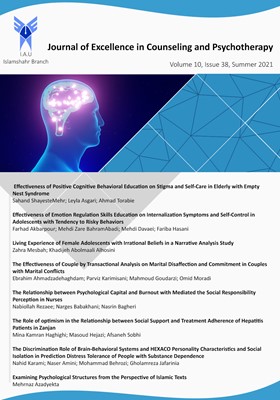-
-
List of Articles
-
Open Access Article
1 - Effectiveness of Positive Cognitive Behavioral Education on Stigma and Self-Care in Elderly with Empty Nest Syndrome
Sahand ShayesteMehr Leyla Asgari Ahmad Torabie -
Open Access Article
2 - Effectiveness of Emotion Regulation Skills Education on Internalization Symptoms and Self-Control in Adolescents with Tendency to Risky Behaviors
Farhad Akbarpour Mehdi Zare BahramAbadi Mehdi Davaei Fariba Hasani -
Open Access Article
3 - Living Experience of Female Adolescents with Irrational Beliefs in a Narrative Analysis Study
Zahra Mesbah Khadijeh Abolmaali Alhosini -
Open Access Article
4 - The Effectiveness of Couple by Transactional Analysis on Marital Disaffection and Commitment in Couples with Marital Conflicts
Ebrahim Ahmadzadehaghdam Parviz Karimisani Mahmoud Goudarzi Omid Moradi -
Open Access Article
5 - The Relationship between Psychological Capital and Burnout with Mediated the Social Responsibility Perception in Nurses
Nabiollah Rezaee Narges Babakhani Nasrin Bagheri -
Open Access Article
6 - The Role of optimism in the Relationship between Social Support and Treatment Adherence of Hepatitis Patients in Zanjan
Mina Kamran Haghighi Masoud Hejazi Afsaneh Sobhi -
Open Access Article
7 - The Discrimination Role of Brain-Behavioral Systems and HEXACO Personality Characteristics and Social Isolation in Prediction Distress Tolerance of People with Substance Dependence
Nahid Karami Naser Amini Mohammad Behrozi Gholamreza Jafarinia -
Open Access Article
8 - Examining Psychological Structures from the Perspective of Islamic Texts
Mehrnaz Azadyekta
-
The rights to this website are owned by the Raimag Press Management System.
Copyright © 2021-2025







